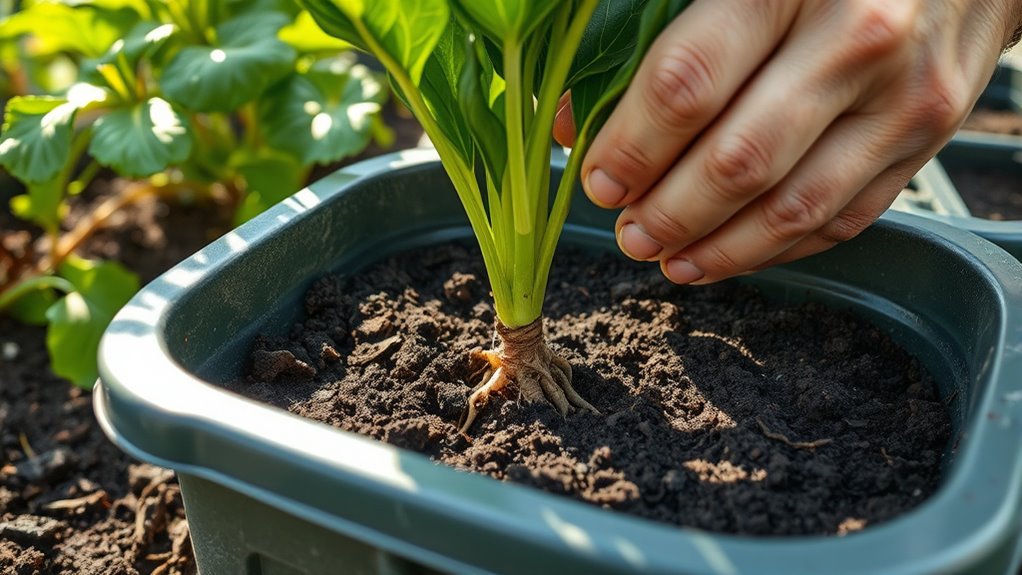Root cutting for free plants is a simple, traditional skill that anyone can learn to multiply their garden without extra costs. You choose healthy stems, cut just below a node, and place them in water to develop roots. With patience, proper light, and regular water changes, you’ll soon see new roots emerge and plants form. Keep practicing this eco-friendly method, and discover how easy it is to grow your garden naturally and affordably. If you continue exploring, you’ll find more tips to succeed.
Key Takeaways
- Water propagation is an easy, cost-effective method to multiply plants at home without soil or special equipment.
- Select healthy stems with nodes, remove lower leaves, and submerge in water to encourage root development.
- Consistent water changes and proper lighting are vital for successful rooting and avoiding rot.
- Roots typically take weeks to develop; patience and observation are essential.
- Once roots are a few inches long, transfer cuttings to soil for continued growth and plant establishment.

Starting your own plants from cuttings is a simple and cost-effective way to expand your garden. It’s a skill many gardeners have forgotten but can easily reclaim. Propagation techniques are diverse, but one of the easiest and most accessible methods involves water propagation. This approach allows you to root cuttings without special equipment, making it perfect for beginners or anyone wanting to save money on new plants.
Learn to easily grow new plants from cuttings with water propagation—cost-effective and perfect for beginners.
To begin, choose healthy, disease-free stems from your favorite plants. Usually, a few inches of stem, with a couple of leaves, is enough. Cutting just below a node—the point where leaves attach—helps encourage root growth. Once you’ve made your cut, remove the lower leaves to prevent rot when submerged in water. This step is essential because decaying leaves can introduce bacteria that hinder root development.
Water propagation is straightforward. Fill a clean glass or jar with room-temperature water and place your cuttings into it, ensuring that at least one node is submerged. Position the jar in a bright but indirect light spot. Direct sunlight can cause the water to heat up and promote algae growth, which isn’t ideal. Change the water every few days to keep it fresh and oxygenated. Watch your cuttings closely over the next few weeks. Roots should start to appear from the nodes within a few weeks, depending on the plant species.
Once you see a healthy root system—typically a few inches long—you can transfer your new plant into soil. Use a well-draining potting mix, and plant the rooted cutting gently. Keep the soil moist but not waterlogged, and continue to provide bright, indirect light. With proper care, your new plant will settle in and grow vigorously. Water propagation not only saves money but also allows you to experiment with different plants without investing in expensive nursery plants.
This method also has the advantage of giving you a clear view of root development, so you know exactly when your cutting is ready for soil. It’s a rewarding process that reconnects you with a traditional gardening skill, one that’s been overshadowed by commercial plant sales. By mastering water propagation, you gain independence from store-bought plants and create a sustainable, budget-friendly garden. Plus, it’s satisfying to watch tiny roots emerge and turn a simple cutting into a thriving new plant. Color accuracy and proper lighting conditions can significantly influence the success rate of rooting cuttings, ensuring healthier growth. Remember, patience is key—most cuttings need a few weeks to root successfully, but the effort pays off in the form of healthy, free plants that you grew yourself.
Frequently Asked Questions
What Is the Best Time of Year to Root Cuttings?
You should consider seasonal timing and plant dormancy when rooting cuttings. The best time is typically during spring or early summer when plants are actively growing, ensuring healthy root development. Avoid rooting during fall or winter, as many plants enter dormancy, making it harder for cuttings to establish roots. By timing your efforts right, you’ll increase your chances of successful, free plant propagation.
How Can I Identify Healthy Cuttings for Rooting?
Did you know that over 80% of successful plant propagation starts with healthy cuttings? To identify these, look for vigorous, green stems with no signs of disease or pests. Use pruning techniques to select sturdy, non-flowering shoots, and check for a healthy plant hormone level that promotes root growth. Avoid damaged or wilted stems; healthy cuttings will root faster and develop stronger roots.
Do Different Plant Species Require Different Rooting Methods?
Yes, different plant species require species-specific techniques for successful rooting. Some plants, like succulents, need well-draining soil and minimal moisture, while others, such as woody shrubs, benefit from specific pruning and moisture levels. Using the right rooting hormone varieties can boost success, as some contain rooting stimulants tailored to particular species. Always research your plant’s needs to choose the best method, ensuring healthy, thriving cuttings.
How Long Does It Typically Take for Cuttings to Root?
You’re wondering how long it takes for cuttings to root. Typically, it varies based on the plant and propagation techniques, but most cuttings root in a few weeks to a couple of months. During this time, you should regularly assess plant health, ensuring proper moisture and light. Patience is key—monitor your cuttings closely, and your efforts will reward you with healthy new plants.
What Are Common Mistakes That Prevent Successful Rooting?
A stitch in time saves nine, and avoiding common mistakes helps guarantee successful rooting. You might fail if you don’t use proper propagation techniques, like selecting healthy cuttings and providing the right moisture and light. Overlooking pest prevention can also sabotage your efforts, inviting diseases and pests that hinder root development. Pay attention to these details, and you’ll increase your chances of rooting cuttings successfully and growing thriving plants.
Conclusion
As you nurture your cuttings, remember that sometimes the simplest skills can lead to unexpected rewards. It’s funny how a small, overlooked technique can turn into a free garden full of life. Just like finding a lost treasure, rooting cuttings reminds you that patience and a bit of effort often pay off in ways you never imagined. Keep practicing, and you’ll discover that nature’s generosity is always just a tiny step away.











